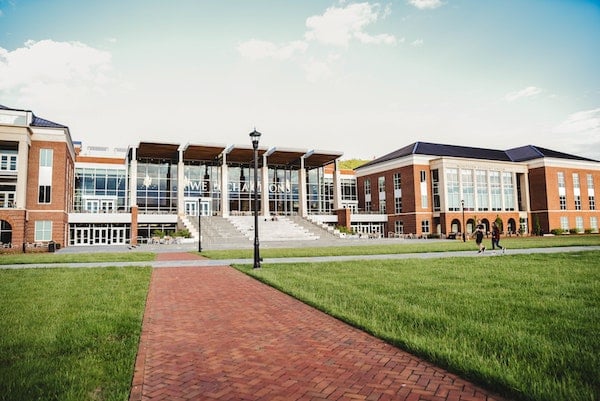Published on
Is Incremental Credentialing Compatible with Institutional Accreditation? (Part 3)

A Conversation with the Middle States Commission n Higher Education
Many in higher education believe it is difficult–if not impossible–to undertake large-scale innovations due to accreditation requirements. Our postsecondary system is degree-centric, organized around associate, baccalaureate, master’s, and doctoral degrees. The entry of nondegree credentials into these waters is not sitting so well; many are pointing to the challenges around quality assurance, and some are viewing nondegree credentials as an intrusive new species threatening to push out traditional degrees. Within this complex, rapidly changing system of educational waterways, there are many checks and balances–key among them, the requirements of institutional accreditation for approved colleges and universities.
The Credential As You Go (CAYG) initiative is proposing a major transformation of postsecondary education to an incremental credentialing system. What would this transformation mean for quality assurance, especially for accreditation? Is an incremental credential system compatible with accreditation? We recently interviewed Dr. Christy Faison, Senior Vice President for Accreditation Relations at the Middle States Commission on Higher Education (MSCHE), to explore these issues in a three-part conversation. Part 3 focuses on who benefits from incremental credentialing and equity considerations, accreditors’ readiness in changing the credentialing ecosystem, and the drivers for change and how best to explain CAYG.
Nan Travers (NT): Who might be served better than they are now through an incremental credentialing system?
Christy Faison (CF): I was unfamiliar with the whole incremental way of thinking about education before I became a part of the CAYG effort. The more I heard about it, the more light bulbs were going off in my head around individuals who do not have the access and ability to complete programming in two-year and four-year chunks. Many students don’t have the liberty to put their lives on hold in two and four-year increments. They have other responsibilities, don’t have the financial wherewithal to make that type of commitment, or require other types of coursework to prepare themselves for their job interests. There are just so many barriers. It’s not just low-income students or non-traditional students. It’s also people who live in areas lacking physical access to higher education institutions. There is a whole range of people who could benefit from incremental credentialing.
I think about education like a race. If everybody is at the same starting line at the same time, then everybody should have the opportunity to get to the finish line. But realistically people are at the starting line at different points with different abilities, and they start the race differently as well. Some are right at the line while some are one step back; some are carrying a heavy backpack; some with running shoes and running gear, others without; some recently went to training camp to learn how to better run the race. They’re all trying to finish the race in different ways.
We need to be aware of these variances. Some students will need to step out, get to a rest stop, and do other things. But they should be rewarded for at least getting to that rest stop, for completing this much of the race. And later they may be ready to get back in the race–be it after two weeks, three months or six years.
What difference does it make to say it took me six years or three months? Because someone else may have done it in less time, does that make my journey any less legitimate? I may have been working full time throughout my educational journey while juggling family responsibilities. But if I dropped out at any point along the way, I would have no recognition. Along the spectrum, there’s no recognition for the work I’ve done, that I struggled to finish, that I may have struggled to finance and for which I earned an A, B or C. That is the equity issue. Regardless of where the starting line was, learners deserve some recognition for their learning to help them toward achieving their goals. This is what our system is not set up to do well at present.
Incremental credentialing could help level the playing field. So, if I’m the individual with the heavy backpack six steps back, I can look at a two-year degree and if it’s not for me because I don’t have the resources, I don’t have the time, I can’t do it right now, perhaps there is another shorter-term credential that has value. There is value in that credential for the individual and society alike if there is recognition for one’s achievements.
NT: Yes, these are inequities that an incremental credentialing system can help address. All our language about leaving school (dropping, stopping out) has negative connotations. The system is saying, ‘You weren’t good enough’ because there is no recognition for learning along the way.
In some countries, we do see systems that have one-, two-, three-, and four-year credentials. Canada is one of them. It has really struck me─why are we letting juniors who don’t finish the senior year, go unrecognized completely if they drop or stop out? Many of us are thinking about credentialing smaller learning units, acquired incrementally. If you can look at smaller pieces of learning and have learning checkpoints, we may actually see better quality and integrity in the whole process.
Holly Zanville (HZ): Are there other issues around quality, related to the checks and balances with regional accreditation?
CF: Accreditors are laser-focused on quality. Any institution that wants to move in this direction will need to provide evidence that the portion of learning for which you are providing a recognized credential is coherent, has appropriate scope and sequence, and is delivered by qualified individuals. It’s the same that we would ask of institutions in any degree program─ the expected outcomes of a program going into it. What is it that I will know and be able to do? How are you measuring that? How are you sharing the success of that measurement with the public transparently, and how are you assessing the overall program?
It’s important to note that the institutional accreditors, formerly known as regional accreditors, are not programaccreditors. Because we accredit an institution as a whole, we are looking more at an overall summary of the student learning experience of in various programs but not specifically looking to validate chemistry or English programs, for example.
There is an important July 2020 regulation imposed by the United States Department of Education that affects components of incremental credentialing. Prior to July 1, 2020, if an institution was proposing a new program at a credential level higher or lower than they are approved to offer, it had to be reviewed by the Commission as a substantive change before we could approve it. With the new regulations, if an institution is going to offer something at a lower credential level than what is currently in the institution’s scope of accreditation, the institution will not need our approval through the substantive change process.
HZ: So, if a community college is going to offer a baccalaureate degree, you must provide approval, but for a four-year institution wanting to offer an associate degree, you would not?
CF: Yes, we would have to approve the community college baccalaureate degree because that’s a higher level. But if a baccalaureate institution was going to offer an associate degree, we would not need to approve it because the institution is already approved to offer a higher credential level. Whatever credential levels an institution offers, the accreditor’s evaluation would include because the Commission’s standards comprise all learning experiences, regardless of modality, location, level, pace, or schedule. So, we would look at the associate degree for the four-year institution within that review. But again, I want to remind you that institutions need approval from state regulatory agencies related to offering degrees.
HZ: And if a four-year institution is going to bring in three badges or some other type of microcredential, does that require approval?
CF: We would not need to approve that program because the institution is already approved to offer bachelor’s degree programs, and these would be considered lower credential levels. However, if the program falls into another category where approval is required, such as distance education, correspondence education, or direct assessment, then it would trigger a review and approval process. Other than that, once approved to offer a credential level, institutions are approved to offer any program at that level.
HZ: Post pandemic, we’re likely to have many hybrid programs. What if the future looks more like students moving toward the baccalaureate, getting three badges along the way, then dropping out. They have three badges but no one knows because the badges may not be on their transcript. Will you be reviewing these developments?
CF: We do expect to see these changes─and when we do, the institution needs to demonstrate the program’s coherence, but these pieces can indeed stand alone and represent high quality.
HZ: Do you get involved in questions around the Comprehensive Learner Record, or ways to change the college transcript to reflect these different kinds of credentials?
CF: That’s a little granular for us. Our focus is on student outcomes─that they are appropriate and that you are transparent about them, but we don’t have specific standards around displaying them on a transcript.
NT: How ready are accreditors for the changes in an incremental credentialing system?
CF: We have to be open to understanding that institutions, especially post COVID, are going to be looking at a variety of ways to reposition themselves to survive and thrive. And we definitely do not want to be perceived as barriers to innovation that benefits students. So, we will have to ensure our practices and procedures align with higher education trends, revisit policy and procedures as necessary, and have fruitful discussions with the entire Commission around areas where our institutions are moving. We are starting to have these conversations already, always mindful of limitations that may stem from federal regulations. As we look at incremental credentialing, we will examine how well this mechanism serves students, the public and society. Then we will analyze how the work of accreditation can shift to address any barriers or stumbling blocks. We can also become a resource for institutions, as they will have an opportunity to learn about innovative practices of others by connecting through the work we do.
HZ: Do you think all the institutional accreditors will be dealing with these issues?
CF: Quality is at the forefront of what accreditors are charged with: the mission-centric assessment of our institutions, so we can be attuned to what the institution wants to accomplish. Incremental credentialing will be an issue for accreditors because institutions are more mindful of their students’ needs and making changes to meet students where they are. It is certainly not just our Commission’s institutions looking at this.
HZ: What are the drivers for this type of change?
CF: The biggest driver now is the pandemic. Before the pandemic, higher education was accused of moving at the speed of the Titanic stuck in the iceberg. But the pandemic has opened the eyes of many in our external community who saw all of higher ed globally change its delivery model in a two-week span. It opened the eyes of the people internally, who asked themselves, ‘Did we know we could do that?’
I didn’t know we in the higher education community could do what we did this past year. Was it perfect across all institutions? No, we are certainly willing to admit that. However, we kept students learning, and accreditors learned alongside them as we went along this journey too. Faculty and staff have been resilient. They have upskilled, worked harder, tried to find new ways to engage students. And the pandemic revealed far more about the students served by our institutions. They’re sitting in basements; they have children, siblings, and parents at home, pets running around them; they lack access to broadband and other technologies to support their learning at home. Yet, they have been resilient. Institutions have gained confidence now that have proven they can thrive in a crisis, as have students as they learned to find a way forward in the most difficult and challenging circumstances. And now we have given ourselves permission to pivot, change, and innovate─and we’ve given ourselves permission to not do it perfectly.
If you look at all of the emerging COVID survey results, they are about serving students, faculty, and staff and looking after their well-being; then later shifting to finances. Obviously those are going to rise to the top as concerns, but the initial concerns are about helping people survive and thrive. I think that spirit will carry over. We will be more mindful of supporting students through a learning environment that helps them not only survive but thrive, and that may mean continuing to do things differently.
But will all institutions want to develop incremental credentials? Some are residential four-year institutions that predominantly offer face-to-face instruction, and they may not be interested in developing these delivery approaches because their students do not want that experience. But I think more institutions will be open to serving student needs differently, looking for ways to meet students where they are, and delivering instruction in ways that help them move forward, whether within the workforce or Continuing Education. I’m really buoyed up by what higher education has been able to do in the last year and the conversations we are having now. I have been participating in a lot of conversations and none of them are gloom and doom.
HZ: What do you think the temperature for more change is like?
CF: We expect changes in our educational system going forward. We are not hearing from institutions that they can’t wait to go back and do exactly what they did before the pandemic. Instead, we are hearing more that these are changes they will adopt permanently moving forward. How can we make that happen? How do we restructure our physical facilities to do that? Those are the conversations taking place among educators. How can we take what we learned during the pandemic and adapt to serve students? Incremental credentialing will make sense as an option. The missions of our higher education institutions are diverse enough to accommodate different learners, so I’m hopeful, really hopeful for change.
NT: CAYG talks about how it’s punitive to individuals not to recognize learning that occurs along the learner’s journey. It’s punitive also to the institution because they get credit for completers in institutional and state performance goals. So, in that respect, if you can show incremental credentials are awarded, maybe that would help promote better outcomes and these data would in some ways be a more honest number because the institution has put in the effort, provided the courses. If an institution does not award credentials for incremental learning and students step away, the institution has failed to help the student acquire meaningful learning.
HZ: How will institutions deal with trying to take the curriculum modular?
CF: We should question why this even is a problem. For anyone who has ever taught, that is what you have to do. You have to take the curriculum and break it down into smaller chunks. It is not an impossible task—it is within every educator’s skillset. What perhaps we have not had is the time to do it, the permission to do it, the opportunities to do it, the conversations around doing it, stakeholder buy-in to do it. If we give faculty what they need, this is in their wheelhouse, and more attention would be paid to modularizing the curriculum if that was the desire of the institution. Accreditors learned how critical centers for teaching and learning became during the pandemic because they help faculty think about ways to deliver content they may not have previously considered.
HZ: Is there a better term for incremental credentialing that campuses would resonate with more easily?
CF: It is a mouthful and a little much for people to get their heads around or for students to understand. But I am not sure what else to call it. Before I became affiliated with CAYG, we were calling it non-degree options, but that does not quite get at it—it almost places a negative spin on it. So, while I am not opposed to the term incremental credentialing, there probably is a term that can better reference the concept, ensure it is understood by the students who benefit from it, and resonate throughout the higher education community.
HZ: This is a good place to end our conversation─hopeful about changes in the way we provide higher education.
Disclaimer: Embedded links in articles don’t represent author endorsement, but aim to provide readers with additional context and service.


